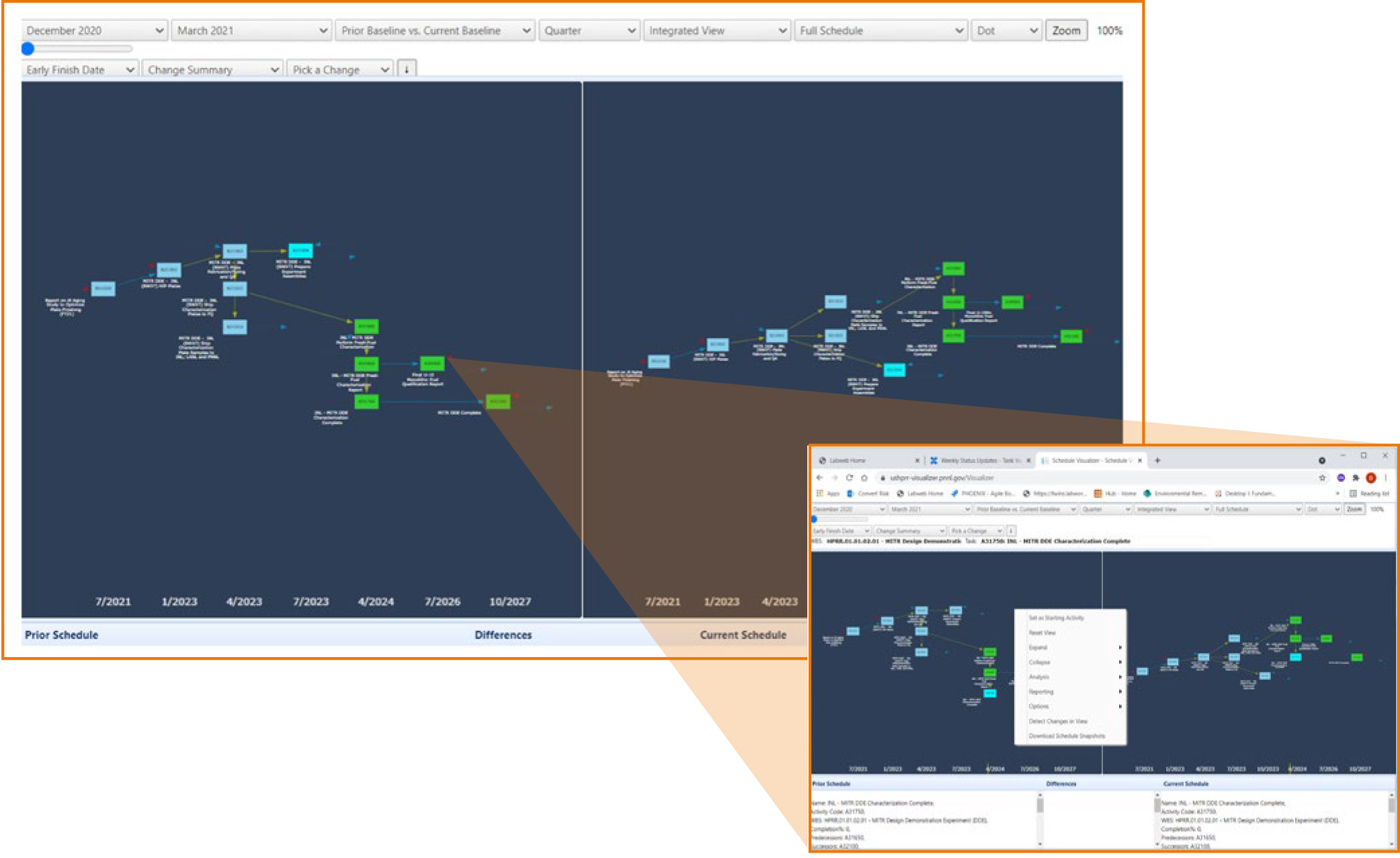About Project Schedule Visualizer
Features and Benefits
Researchers at PNNL have applied expertise in network graph theory, computer science, software engineering, and project risk analysis to develop the Project Schedule Visualizer (PSV). This web application enables professionals in various roles, with differing levels of domain expertise, to consider the impacts of risks on project schedules by using a risk-embedded schedule.
PSV uses the Oracle P6 software framework and integrates tree and branch visualizations that are easier to interpret than typical—and highly technical—Gantt chart outputs. These clear, simple visualizations also make it easier to compare schedules side by side to see where changes occurred. The result is a tool that is intuitive even for users who only need high-level information or who lack formal software user training.
Another feature is the ability to compare multiple schedule configurations, such as the risk-embedded schedule, from one month to the next. A user also can compare the probability distributions for primary and mitigated risks.
Before beginning detailed risk analysis, a project risk analyst can use PSV to view differences between various schedule combinations, such as baseline-to-baseline, baseline-to-risk, and risk-to-risk. Because the software generates easy-to-understand schedule visualizations and can render side-by-side changes in values, project managers can readily compare specific critical paths before and after a schedule change, either as part of evaluating project health or in a “what-if” analysis to consider alternatives. This yields important information about how schedule adjustments impact milestones.
PSV is already in use and proven for a multi-million-dollar Department of Energy project with schedules imported from widely used commercial project schedule risk management software. The web-based nature of the application allows seamless visualization of read-only schedules by geographically dispersed users. The software can also be deployed as a standalone web application on a user’s laptop.

Features At A Glance
PSV offers much of the same basic functionality as widely used commercial project schedule risk management software, at significantly lower cost. In fact, the tool is available at no cost to academic, non-commercial, and federally contracted users.
- Easy to learn and easy to use for non-project-control professionals
- XER export compatible
- Currently compatible with Oracle P6, and could be expanded through collaborative development
- Quickly visualize risk and project flow
- Features variance justification
- View one schedule or conduct split-screen comparisons of two schedules—make visual layout changes to one schedule and the other is automatically updated
- Easily navigate to choose historical schedules and views
- Analyze schedules for maturity
- Render robust schedule layouts or only critical paths
- Choose between skeleton and detailed task views
- Analyze schedules for weaknesses
- Evaluate data using different visualization formats—with dates, without dates, circular view, left-to-right flow, and more
- Zoom in and out of schedule and view slices as desired—especially helpful for projects with hundreds to thousands of tasks
- Use visual cues to quickly spot changes made in a schedule or task, or to review summary task information
- Automatically populate drop-down menus with analysis of schedule-based changes
- Use the sleek, intuitive search function to find a task without remembering codes
- Complements Gantt chart views
- Compare schedules with and without a realized risk
- Quickly identify nearest milestones and associated changes
- Use the Reporting feature—view reporting on how many tasks have been added or removed, see what changes have occurred between two schedules, and export reports to Excel
- Minimal training required—users can be off and running with a few hours of instruction and the supplied user guide, compared to multi-day bootcamps required for other, more complicated tools
- Trial software available now
Options for Use
PSV is a proprietary copyrighted software that is ready for plug-and-play deployment in all fields with a user license.
With further development, licensees of PSV can also incorporate the software into existing project management tools or provide it to consumers as a standalone solution for managing large, multi-year, and highly complex projects.